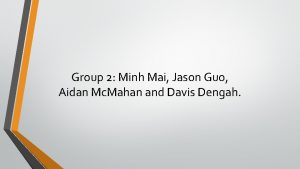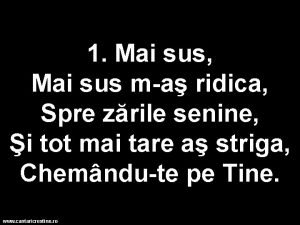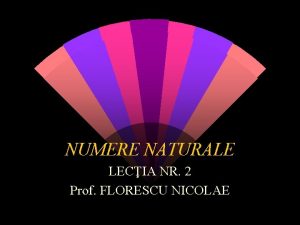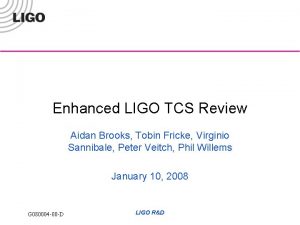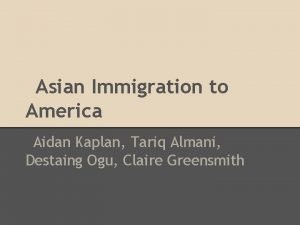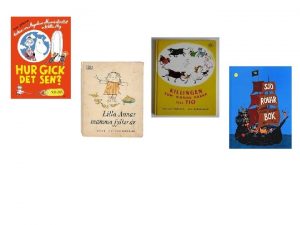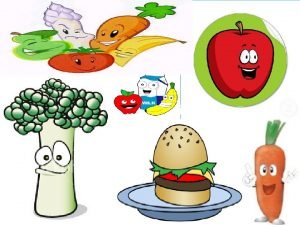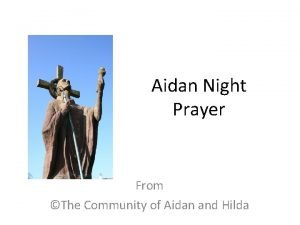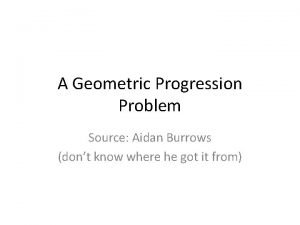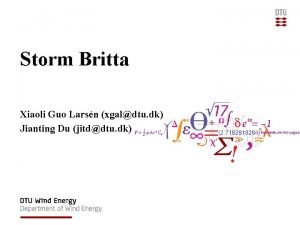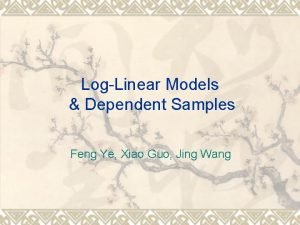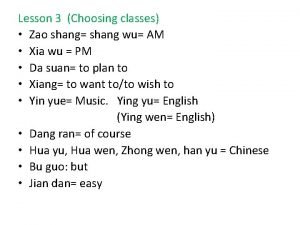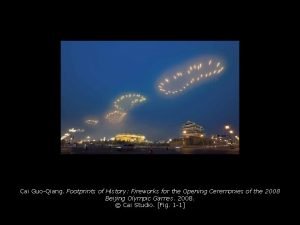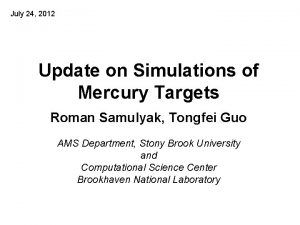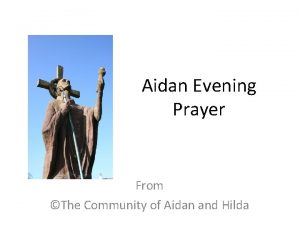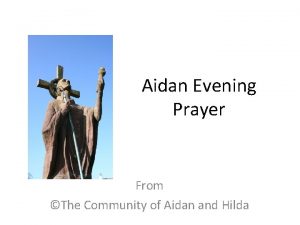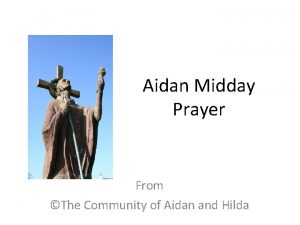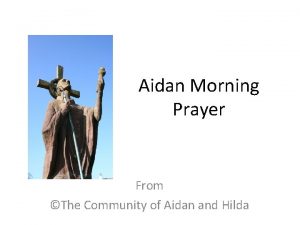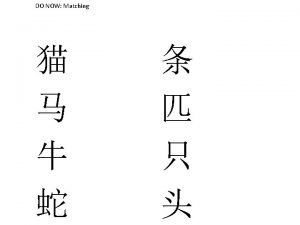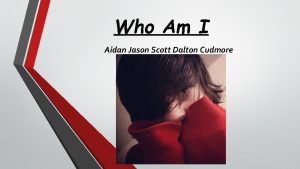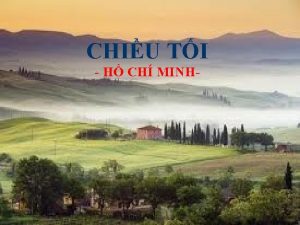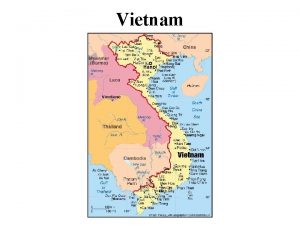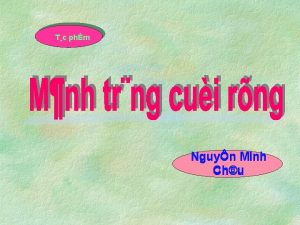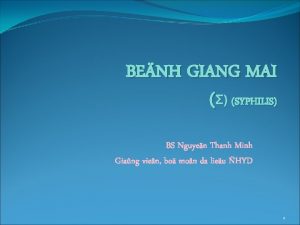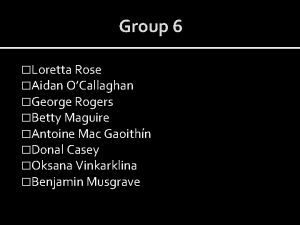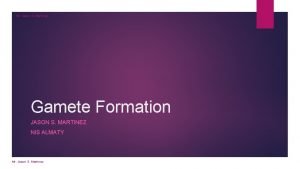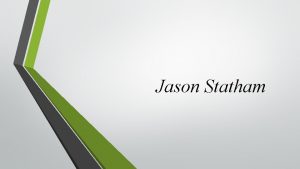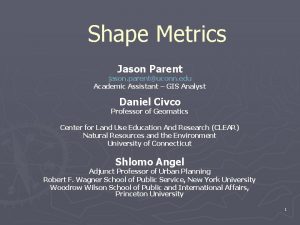Group 2 Minh Mai Jason Guo Aidan Mc




















- Slides: 20

Group 2: Minh Mai, Jason Guo, Aidan Mc. Mahan and Davis Dengah.

Background Information Ø William Blake (November 28 th – August 12 th 1827). Ø Born in Soho, London, United Kingdom. Ø Married to Catherine Boucher, however, he had no children. Ø He was an English poet, painter and printmaker. Ø The originator of the Romantic movement in English poetry history. Source: https: //en. wikipedia. org/wiki/William_Blake

The Tyger William Blake

General Analysis v The Tyger is made up of six quatrains and rhyming couplets. v Consists of AA BB CC DD EE FF GG HH II JJ AA BB rhyme scheme. v Throughout The Tyger, Blake uses loads of alliteration, metaphor, imagery, personification and rhetorical situation to make the poem more vivid. v Pillar of Romanticism: Awe of Nature. Ø Awe of the powerful creature, the Tyger. Ø Awe of the even more incredibly powerful creator when he himself created the Tyger.

“Tyger! burning bright In the forests of the night, ” Alliteration: Repetition of words and sounds. The repetition of the word “Tyger” demonstrates the topic of the poem, it also gives readers the sense of mystery and the powerful feeling of the scary creature. The “burning bright” in the forests of the night shows how powerful and bright the Tyger is as he lightens up the whole forest with his dominance.

“What immortal hand or eye? Could frame thy fearful symmetry? ” These two lines state the central problem of the poem. It is Rhetorical Situation, so the writer doesn’t show the answer. However, we can infer the “immortal” is God and the "fearful" is the Tyger. In addition, the word "Could" also contributes to a gentle tone at the beginning of the poem – Blake formally asking a question.

"In what distant deeps or skies Burnt the fire of thine eyes? " The alliteration of “distant” and “deeps” illustrates the severely far distance from the world. The two lines ask where the Tyger is created and the use of “distant deeps or skies” refer to hell or heaven. The burning metaphor returns to add to the power and fearfulness image of the Tyger.

"On what wings dare he aspire? What the hand dare sieze the fire? " It is vague and unclear how Blake uses “he” in that line. Is he the Tyger or the creator? The wings, nonetheless, imply to something supernatural, might be the angel, but they are not necessarily a divine one since seizing the fire exemplifies hell.

"And what shoulder, & what art, Could twist the sinews of thy heart? " The word "shoulder" refers to the bodily strength whereas "art" refers to the skillfulness of the creator. Through the rhetorical situation, Blake is asking the audience who is that powerful person that could make such a powerful creature like Tyger? - The answer is God.

"And when thy heart began to beat What dread hand? & what dread feet? " Dread hand dread feet refer to the Tyger’s paws.

"What the hammer? what the chain? In what furnace was thy brain? What the anvil? what dread grasp Dare its deadly terrors clasp? " In this forth stanza, Blake uses a metaphor of a blacksmith and that he is using tools such as hammer, furnace (fire) and anvil to create metal. We can see the tone is changing from this stanza as Blake applies strong, extreme words like dread, dare, deadly and terrors.

"When the stars threw down their spears, And water'd heaven with their tears, " Blake utilizes personification in these 2 lines implying the stars are the angels and they are fighting against such a mighty creation, yet they lose to the creator, God. The gloomy heaven is full of tears and disappointments.

"Did he smile his work to see? Did he who made the Lamb make thee? " Rhetorical Situation and Juxtaposition. Again, Blake wonders if God is proud of his creation? Why would God make such an evil animal, the Tyger, when before he already made an innocent animal like the Lamb? The contrast between the tame Lamb and the fierce Tyger shows how almighty God is when he has such power to create both the creatures.

"Tyger! burning bright In the forest of the night, " The first sentence of last stanza repeats the first sentence of the first stanza in order to emphasize the power and mightiness of the Tyger. The tone has changed.

"What immortal hand or eye Dare frame thy fearful symmetry? " The lines are repeated to remind the audience about the topic and the central question of the poem. However, Blake changes the word “Could” into “Dare” in the last line, showing that the tone completely changes into extreme intensity, ending the poem with a severe attitude.

Theme The theme of The Tyger is comparing the Tyger to Satan or the Devil. This poem is opposite to the poem The Lamb talks about the good and God. But the Tyger is about the evil and the devil that lives in all of us. The theme is also about the mystery of our almighty God’s creations which he is so infinitely powerful that human’s mind cannot comprehend since our mind is limited.

Tone The tone of the poem Tyger is fear. William Blake’s poem is trying to put fear in the readers. He does this in saying "When the stars threw down their spears And water'd heaven with their tears" (Line 17 -18). In saying this you can relate if from death from above. Spears are being thrown from above you and angles from heaven are crying.

Images sources • • https: //prezi. com/m/64 baienqcvq 5/william-blakes-the-lamb-the-tyger/ https: //www. biography. com/people/william-blake-9214491 https: //sites. google. com/a/kentdenver. org/jbird-s-poetry/home/the-tyger https: //www. pinterest. com/pin/433682639101022128/ https: //play. google. com/store/apps/details? id=com. tmsoft. eternalfire https: //layers-of-learning. com/wp-content/uploads/2017/07/Songs-of-experience-the-tyger-1. jpg https: //www. flickr. com/photos/pokerbrit/26921092445 https: //ak 1. picdn. net/shutterstock/videos/6408131/thumb/1. jpg

• • • https: //img 00. deviantart. net/fc 2 d/i/2010/266/c/3/tiger_fire_demon_by_elen 89 -d 2 z 6 p 5 k. png • • http: //rebrn. com/re/psbattle-a-tiger-standing-over-another-tiger-arms-outstretched-57242/ https: //cdn. instructables. com/FWF/8 UQ 2/ISZCS 00 D/FWF 8 UQ 2 ISZCS 00 D. MEDIUM. jpg https: //wallpaperstock. net/deep-sky-desert-way--plants-wallpapers_w 40052. html https: //c 2. staticflickr. com/4/3056/2913483894_8 a 915 e 3314_z. jpg? zz=1 http: //www. pptbackgrounds. org/red-heart-beats-backgrounds. html http: //media. agonybooth. com/wp-content/uploads/2016/08/05225300/Screen-Shot-2013 -10 -21 -at 7. 06. 14 -AM. png https: //www. artsfon. com/pic/201511/1920 x 1080/artsfon. com-75780. jpg

THE END
 Dr minh mai
Dr minh mai Mai sus mai sus
Mai sus mai sus Scrieti in ordine crescatoare nr naturale mai mici decat 12
Scrieti in ordine crescatoare nr naturale mai mici decat 12 Nau mai haere mai meaning
Nau mai haere mai meaning Mechanical engineering rit
Mechanical engineering rit Aidan brooks hunt
Aidan brooks hunt Blackpool population
Blackpool population Aidan greensmith
Aidan greensmith Bcker
Bcker Aidan horan
Aidan horan Laing carbs
Laing carbs Aidan solomon
Aidan solomon Dr aidan hampson
Dr aidan hampson Community of aidan and hilda
Community of aidan and hilda Aidan burrows
Aidan burrows Lixiong guo
Lixiong guo Xiaoli guo larsén
Xiaoli guo larsén Feng guo symmetry
Feng guo symmetry Zao shang hao jung wo
Zao shang hao jung wo Cai guo qiang footprints of history
Cai guo qiang footprints of history Tongfei guo
Tongfei guo
